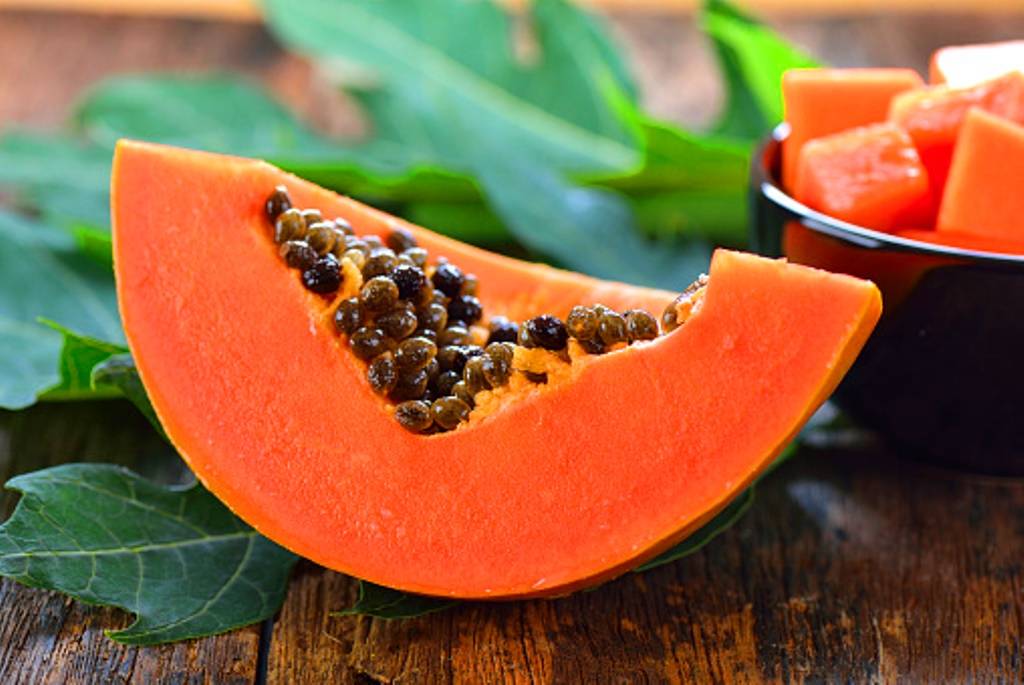
The great voyager Christopher Columbus used to refer to papaya (Carica papayaL.) as “Fruit of the Angels” which makes you love it is due to the presence of the miracle enzyme papain along with other rich sources of vitamin A, B, C, K and minerals such as calcium, potassium, and magnesium.
It’s loaded with antioxidants that can reduce inflammation, fight diseases and help keep you looking young. While consuming papaya natures best will pave the way for reducing the risk of heart diseases, diabetes, cancer, asthma, age-related macular degeneration, aiding in digestion, improving wound healing, and excellent immunity booster.
Losses due to post-harvest diseases ranged from 1-93 percent depending on post-harvest handling and packing procedures. Most post-harvest diseases occur when pathogens enter through small wounds after harvest. The major post-harvest diseases which lower the market values are as follows.
Anthracnose
When the infected fruits have 25% or more skin yellowing, beads of latex are exuded at the fruit surface and small water-soaked spots appear. As the infection advances, a circular sunken lesion with translucent light brown margins forms, and on cross-section view, a greyish-white discoloration is seen that later turns brown. A layer of firm callose tissue forms at the border of the soft semi-circular lesion.
Stem-end rot
After harvest fungi, as well as fungal spores, invade through the crevices between the peduncle or through small wounds. When the fungal hyphae invade the vascular tissue, a slight browning can be seen at the peduncle. As the infection advances, the lesion margin remains translucent while the remaining infected tissue becomes black, wrinkled and dry. At an advanced stage of infection, white mycelium forms at the stem end.
Rhizopus rot
When the fruit is 40-60% yellow, cuticle disruption occurs, as latex vessels break down. The fungus enters through the breaks in the cuticle or through the punctures made by the fruit fly. Infected fruits become covered by a mass of coarse grey mycelium and finally, fruit gets watery fruit rot.
Phomopsis rot
Infected tissue wrinkles become translucent and a band of water-soaked tissue advances rapidly towards the fruit cavity which can be lifted free from the rest of the fruit.
Alternaria fruit spot
Circular to oval black lesions that become covered with black spore masses are the symptoms of Alternaria infections.
To maintain the quality of the fruit for high returns
-
At the beginning of the fruit set, about 6-8 months after planting entire fruit and flower columns is sprayed with mancozeb at a concentration of 2gm per liter of water, once in every 10 days interval or Chlorothalonil @ 2 g/litre of water at 10 to 15 days interval.
-
Depending on the market destination, the fruits should be harvested as soon as they mature. Harvest fruits when it is 10-15% yellow or when a yellow coloration begins to develop in the base of the fruits.
-
Harvest the fruits late in the morning to the early afternoon which causes a reduction in latex flow.
-
The fruits should be handpicked with the pickers wearing gloves in order to prevent bruising.
-
If the trees were much taller, a wooden or bamboo pole fitted with a cutting instrument with a catching net at the end of the harvesting pole was used to prevent the fruit to drop to the ground during picking.
-
Do not break off the fruit stem too close to the fruit as this will damage the tissue at the stem end of the fruit which causes stem end rot to lead to spoilage.
-
Rough handling results in bruising causes rapid development of decay and ripening.
-
Throwing of fruit should never be practiced. This results in bruising and sometimes internal damage occurs.
-
Postharvest diseases are effectively controlled by double hot water immersion treatment consisting of an initial 30-minute immersion at 42°C followed by a 20-minute immersion at 49°C.
-
Thiabendazole applied at 4-8 g per liter concentration with a carnauba wax substantially reduces postharvest decay even for extended storage.
-
The sides and bottoms of the boxes used to transport the fruit from the field to the fresh market should be lined with banana leaves, shredded paper, or tissue paper.
-
When packing the fruits for the market they should be placed in a single layer on their bases with the top or apex pointing upwards.
-
Depending on the size of the fruit for export, pack only 8-16 per one piece of ventilated fiberboard carton weighing 4.5kg.
-
If longer storage is needed, papaya should be stored at or near 10°C and 85-90% RH which will extend the life of the fruit from 10 days to a maximum of 3weeks.
-
If stored at room temperature 25°C, fruits will ripen within 7-10 days.
By Golda S.B, Plant Pathologist, IWDM-K, Chadayamangalam,Kerala
















